
The neon tetra is a Freshwater fish of the characin family of order Characiformes. The type species of its genus, it is native to blackwater and clearwater streams in the Amazon basin of South America. Its bright colouring makes the fish visible to conspecifics in the dark blackwater streams, and is also the main reason for its popularity among freshwater fish hobbyists, with neon tetras being one of the most widely kept tropical fish in the world.

The tinfoil barb is a tropical Southeast Asian freshwater fish of the family Cyprinidae. This species was originally described as Barbus schwanenfeldii by Pieter Bleeker in 1853, and has also been placed in the genera Barbodes and Puntius. The specific epithet is frequently misspelled schwanefeldii.

Polypterus senegalus, the Senegal bichir, gray bichir or Cuvier's bichir, and sometimes called the "dinosaur eel", "dinosaur bichir", or "dragon fish" is in the pet trade due to its lungfish-like appearance, which was described as more primitive and prehistoric than other modern fishes. It is a prototypical species of fish in the genus Polypterus, meaning most of its features are held across the genus. It is commonly kept in captivity by hobbyists. They are native from Africa where they are the most widespread species of the genus.

The rainbowfish or Melanotaeniidae is a family of small, colourful freshwater fish found in northern and eastern Australia, New Guinea, Sulawesi and Madagascar.

The red rainbowfish or salmon-red rainbowfish is a species of rainbowfish from Lake Sentani in Irian Jaya, Indonesia. Belonging to the family Melanotaeniidae, in the subfamily Melanotaeniinae, the Australian rainbowfishes. It is threatened in its native range, but easily bred in captivity and common in the aquarium trade.
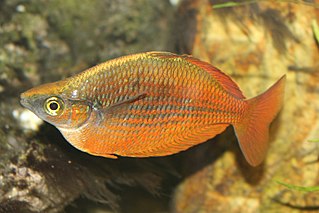
Glossolepis is a genus of rainbowfishes from New Guinea.
Axelrod's rainbowfish is a species of rainbowfish in the subfamily Melanotaeniinae. It is found in Papua New Guinea in the Yungkiri stream in the north western part of that nation. Typically its preferred habitat is a narrow stream with gentle moving, cloudy water surrounded by lush rainforest.
The Sentani rainbowfish is a critically endangered species of rainbowfish in the subfamily Melanotaeniinae. It is endemic to West Papua in Indonesia, where restricted to Lake Sentani and its tributaries. It appears to have disappeared from the lake itself due to pollution and introduced species. Another rainbowfish, Glossolepis incisus has a similar range. Although a small population of the Sentani rainbowfish is maintained in captivity, it has frequently been confused with the closely related, more thickset C. fasciata.
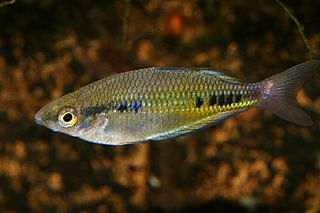
The spotted rainbowfish is a species of rainbowfish in the subfamily Melanotaeniinae. It is endemic to the river systems of the Markham and Ramu Rivers in Papua New Guinea. Papua New Guinea. This species was described by Gerald R. Allen in 1981 with the type locality given as a small tributary of the Omsis River, about 22 kilometers west of Lae in the Markham River system, Papua New Guinea.
The Tami River rainbowfish is a species of rainbowfish in the subfamily Melanotaeniinae. It is found in West Papua in Indonesia. This species can reach a length of 8.0 centimetres (3.1 in) SL.

The Ramu rainbowfish is a species of fish in the family Melanotaeniidae. It is endemic to Papua New Guinea where it occurs in tributary streams of the Gogol River near Madang, but it has also been recorded from the middle Ramu basin. This species was described by Gerald R. Allen in n1985 and the type locality is given as "tributary of Ramu River about 3 kilometers south of Walium Village".
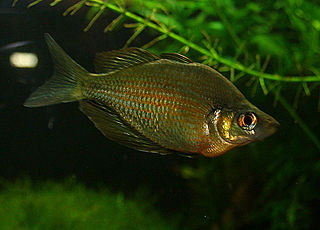
The Lake Wanam rainbowfish is a critically endangered species of rainbowfish in the subfamily Melanotaeniinae. It is endemic to Lake Wanam near Lae in Papua New Guinea. It has virtually disappeared from the small lake due to competition from introduced, non-native tilapias, but captive populations exist.

Boeseman's rainbowfish, also known as the Boesemani rainbowfish, is a species of fish in the family Melanotaeniidae.

The dwarf rainbowfish is a species of rainbowfish in the subfamily Melanotaeniinae. It is known under a number of common names including diamond rainbowfish, neon rainbowfish, Praecox rainbowfish, dwarf neon rainbowfish, peacock rainbowfish, and Teczanka neonowa. It is endemic to the Mamberamo River basin in West Papua in Indonesia and common in the aquarium trade.

The pygmy rainbowfish is a species of rainbowfish in the subfamily Melanotaeniinae. It is endemic to Australia.
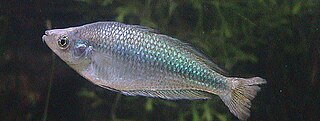
The Australian rainbowfish, known less commonly as the Murray River rainbowfish, is a species of freshwater fish endemic to southeastern Australia. The southernmost species of all rainbowfishes, these fish are very colourful, hence the name; and there is sexual dimorphism with the males being larger and more colourful than females. Australian rainbowfish are schooling fish and will congregate near logs or riverbanks, and are a popular aquarium fish.

The green swordtail is a species of freshwater/brackish fish in family Poeciliidae of order Cyprinodontiformes. A live-bearer, it is closely related to the southern platyfish or 'platy' and can crossbreed with it. It is native to an area of North and Central America stretching from Veracruz, Mexico, to northwestern Honduras.
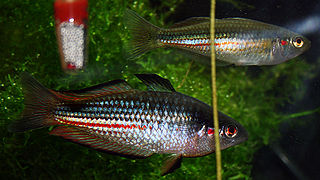
Melanotaenia duboulayi, the crimson-spotted rainbowfish, less commonly known as the Duboulay's rainbowfish, is a species of freshwater fish endemic to coastal eastern Australia. M. duboulayi has also been kept as an aquarium fish since the early 20th century, and is the original "Australian rainbowfish".

The ornate rainbowfish is a species of rainbowfish endemic to an area in eastern Australia, where it is native to coastal regions and sandy offshore islands in southern Queensland and northern New South Wales. It is the only known member of its genus. It is a popular aquarium fish.

Melanotaeniinae the Australian rainbowfishes is a subfamily of the rainbowfishes of the family Melanotaeniidae. They are a group of small, colourful, freshwater fish found in northern and eastern Australia, New Guinea, islands in Cenderawasih Bay the Raja Ampat Islands in Indonesia and in Madagascar.

















